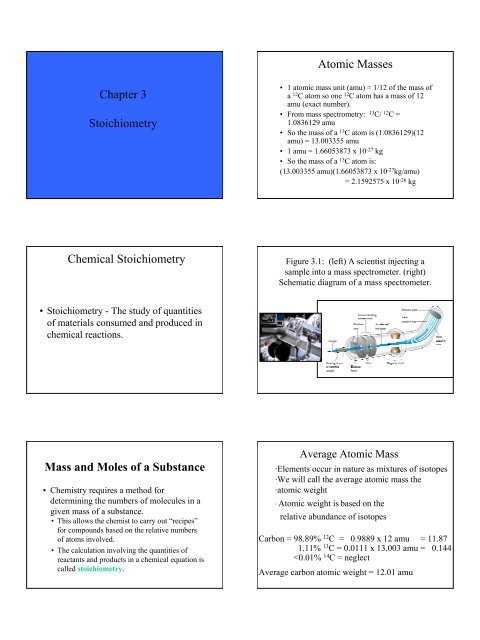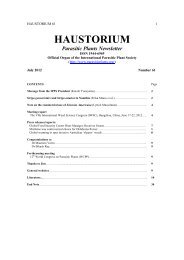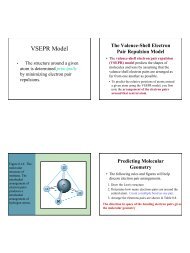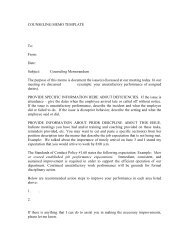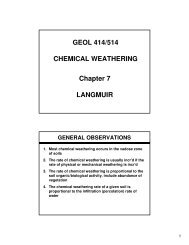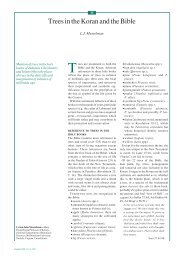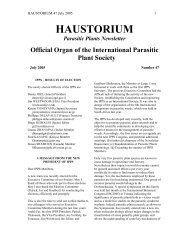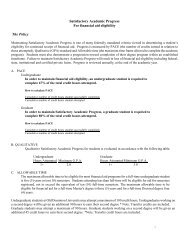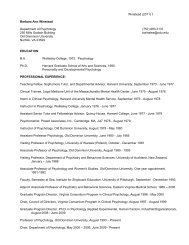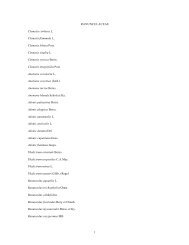Chapter 3 Stoichiometry Chemical Stoichiometry Mass and Moles of ...
Chapter 3 Stoichiometry Chemical Stoichiometry Mass and Moles of ...
Chapter 3 Stoichiometry Chemical Stoichiometry Mass and Moles of ...
Create successful ePaper yourself
Turn your PDF publications into a flip-book with our unique Google optimized e-Paper software.
<strong>Chapter</strong> 3<br />
<strong>Stoichiometry</strong><br />
<strong>Chemical</strong> <strong>Stoichiometry</strong><br />
• <strong>Stoichiometry</strong> - The study <strong>of</strong> quantities<br />
<strong>of</strong> materials consumed <strong>and</strong> produced in<br />
chemical reactions.<br />
<strong>Mass</strong> <strong>and</strong> <strong>Moles</strong> <strong>of</strong> a Substance<br />
• Chemistry requires a method for<br />
determining the numbers <strong>of</strong> molecules in a<br />
given mass <strong>of</strong> a substance.<br />
• This allows the chemist to carry out “recipes”<br />
for compounds based on the relative numbers<br />
<strong>of</strong> atoms involved.<br />
• The calculation involving the quantities <strong>of</strong><br />
reactants <strong>and</strong> products in a chemical equation is<br />
called stoichiometry.<br />
Atomic <strong>Mass</strong>es<br />
• 1 atomic mass unit (amu) = 1/12 <strong>of</strong> the mass <strong>of</strong><br />
a 12 C atom so one 12 C atom has a mass <strong>of</strong> 12<br />
amu (exact number).<br />
• From mass spectrometry: 13 C/ 12 C =<br />
1.0836129 amu<br />
• So the mass <strong>of</strong> a 13 C atom is (1.0836129)(12<br />
amu) = 13.003355 amu<br />
• 1 amu = 1.66053873 x 10 -27 kg<br />
• So the mass <strong>of</strong> a 13 C atom is:<br />
(13.003355 amu)(1.66053873 x 10 -27 kg/amu)<br />
= 2.1592575 x 10 -26 kg<br />
Figure 3.1: (left) A scientist injecting a<br />
sample into a mass spectrometer. (right)<br />
Schematic diagram <strong>of</strong> a mass spectrometer.<br />
Average Atomic <strong>Mass</strong><br />
·Elements occur in nature as mixtures <strong>of</strong> isotopes<br />
·We will call the average atomic mass the<br />
·atomic weight<br />
· Atomic weight is based on the<br />
relative abundance <strong>of</strong> isotopes<br />
Carbon = 98.89% 12C = 0.9889 x 12 amu = 11.87<br />
1.11% 13C = 0.0111 x 13.003 amu = 0.144<br />
Figure 2.11: Diagram <strong>of</strong> a simple mass spectrometer.<br />
Figure 2.12: The<br />
mass spectrum <strong>of</strong><br />
neon.<br />
20 Ne = .907<br />
21 Ne = .003<br />
22 Ne = .090<br />
Atomic Weight <strong>of</strong> Elements<br />
Calculate the average atomic weight <strong>of</strong> boron, B,<br />
from the following data:<br />
ISOTOPE ISOTOPIC MASS (amu) FRACTIONAL ABUNDANCE<br />
B-10 10.013 0.1978<br />
B-11 11.009 0.8022<br />
B-10: 10.013 x 0.1978 = 1.9806<br />
B-11: 11.009 x 0.8022 = 8.8314<br />
10.8120 = 10.812 amu<br />
Conceptual Problem 2.47: Green <strong>and</strong> brown spheres.<br />
X-23: (5/20) x 23.02 amu = 5.755<br />
X-25: (15/20) x 25.147 amu = 18.860<br />
24.615<br />
Average atomic weight = 24.615 amu<br />
The Mole<br />
• One mole is the number equal to the number<br />
<strong>of</strong> carbon atoms in exactly 12 grams <strong>of</strong> pure<br />
12C. • The number = 6.02214199 x 1023 • 1 mole <strong>of</strong> anything = 6.022 × 10 23 units
Avogadro’s number<br />
equals<br />
6.022 × 10 23 units<br />
Molar <strong>Mass</strong><br />
• A substance’s molar mass (or molecular<br />
weight) is the mass in grams <strong>of</strong> one mole <strong>of</strong><br />
the compound.<br />
•CO 2 = 44.01 grams per mole<br />
g/mole<br />
1 C = 12.01<br />
2 O 2 x 16.00 = 32.00<br />
44.01 g/mole<br />
Figure 3.2:<br />
One mole<br />
each <strong>of</strong><br />
various<br />
substances.<br />
Photo<br />
courtesy <strong>of</strong><br />
American<br />
Color.<br />
S 8<br />
C 8 H 17 OH<br />
HgI 2<br />
CH 3 OH<br />
Determining the <strong>Moles</strong> <strong>of</strong> Atoms<br />
How many moles <strong>of</strong> Se atoms are in 20.0 g <strong>of</strong> Se?<br />
20.0 g Se x 1 mol Se = 0.253 mol Se atoms<br />
78.96 g Se molar mass <strong>of</strong> Se<br />
How many atoms <strong>of</strong> Se are in 20.0 g <strong>of</strong> Se?<br />
0.253 mol Se atoms x 6.022 x 10 23 Se atoms = 1.53 x 10 23 Se atoms<br />
mol Se atoms<br />
Write the molecular formula <strong>and</strong><br />
calculate the formula weight for<br />
hydrogen peroxide <strong>and</strong> nitric acid<br />
a) H2O2 2 x at. wgt. H = 2.02 amu<br />
2 x at. wgt. O = 32.00 amu<br />
34.02 amu<br />
b) HNO3 1 x at. wgt. H = 1.01 amu<br />
1 x at. wgt. N = 14.01 amu<br />
3 x at. wgt. O = 48.00 amu<br />
63.02 amu
Determining Molar <strong>Mass</strong><br />
What is the molar mass <strong>of</strong> Al 2 (SO 4 ) 3 ?<br />
1 mol Al2 (SO4 ) 3 x 2 mol Al x 26.98 g = 53.96 g<br />
mol Al2 (SO4 ) 3 mol Al<br />
1 mol Al 2 (SO 4 ) 3 x 3 mol S x 32.07 g = 96.21 g<br />
mol Al 2 (SO 4 ) 3 mol S<br />
1 mol Al 2 (SO 4 ) 3 x 12 mol O x 16.00 g = 192.00 g<br />
mol Al 2 (SO 4 ) 3 mol O<br />
Molar mass <strong>of</strong> Al 2 (SO 4 ) 3 = 342.17 g<br />
= 342.2 g<br />
Percent Composition<br />
• <strong>Mass</strong> percent <strong>of</strong> an element:<br />
mass <strong>of</strong> element in compound<br />
mass % = ×100%<br />
mass <strong>of</strong> compound<br />
• For iron in iron (III) oxide, (Fe 2O 3)<br />
Molar mass <strong>of</strong> Fe2O3 = 159.69 g<br />
<strong>Mass</strong> <strong>of</strong> Fe = 1 mol Fe2O3 x 2 mol Fe x 55.85 g Fe = 111.7 g<br />
mol Fe2O3 mass % Fe<br />
1117 .<br />
= × 100% = 69. 95%<br />
159. 69<br />
Determining <strong>Chemical</strong><br />
Formulas<br />
• Determining the formula <strong>of</strong> a compound<br />
from the percent composition.<br />
• The percent composition <strong>of</strong> a compound leads<br />
directly to its empirical formula.<br />
•An empirical formula (or simplest formula)<br />
for a compound is the formula <strong>of</strong> the substance<br />
written with the smallest integer (whole<br />
number) subscripts.<br />
Figure 3.7:<br />
A welder welding<br />
using an<br />
oxy-acetylene torch.<br />
Photo courtesy <strong>of</strong><br />
PhotoDisc.<br />
CH<br />
acetylene<br />
Figure 3.7: Photo<br />
<strong>of</strong> benzene in lab<br />
glassware.<br />
Photo courtesy <strong>of</strong><br />
American Color.<br />
CH<br />
benzene
Formulas<br />
• molecular formula = (empirical formula) n<br />
– [n = integer]<br />
• molecular formula = C 6 H 6 = (CH) 6 (benzene)<br />
• molecular formula = C 2 H 2 = (CH) 2 (acetylene)<br />
• empirical formula = CH<br />
Another example: hydrogen peroxide OH = empirical formula<br />
H 2 O 2 = molecular formula<br />
Determining <strong>Chemical</strong><br />
Formulas<br />
• Determining the empirical formula from the<br />
percent composition.<br />
– Benzoic acid is a white, crystalline powder used<br />
as a food preservative. The compound contains<br />
68.8% C, 5.0% H, <strong>and</strong> 26.2% O by mass. What<br />
is its empirical formula?<br />
– In other words, give the smallest whole-number<br />
ratio <strong>of</strong> the subscripts in the formula<br />
C x H yO z<br />
Determining <strong>Chemical</strong><br />
Formulas<br />
• Determining the empirical formula from the<br />
percent composition.<br />
– For the purposes <strong>of</strong> this calculation, we will assume<br />
we have 100.0 grams <strong>of</strong> benzoic acid.<br />
– Then the mass <strong>of</strong> each element equals the numerical<br />
value <strong>of</strong> the percentage.<br />
– Since x, y, <strong>and</strong> z in our formula represent mole-mole<br />
ratios, we must first convert these masses to moles.<br />
C x H yO z<br />
Figure 3.5: A schematic diagram <strong>of</strong> the<br />
combustion device used to analyze<br />
substances for carbon <strong>and</strong> hydrogen.<br />
Benzoic acid<br />
Benzoic Acid is a white, crystalline<br />
powder used as a food preservative<br />
which is 68.8% C, 5.00 % H, <strong>and</strong><br />
26.2% O by mass. What is its<br />
empirical formula?<br />
For 100.0 g <strong>of</strong> benzoic acid:<br />
68.8 g C x 1 mol C = 5.73 mol C<br />
12.0 g C<br />
5.00 g H x 1mol H = 4.95 mole H<br />
1.01 g H<br />
26.2 g O x 1 mol O = 1.638 mol O<br />
16.0 g O<br />
divide by 1.638, then empirical<br />
formula is C3.5H3.0O or C7H6O2<br />
Empirical Formula Determination<br />
(when you are given mass percentages <strong>of</strong><br />
elements)<br />
• 1. Base calculation on 100 grams <strong>of</strong><br />
compound.<br />
• 2. Determine moles <strong>of</strong> each element in 100<br />
grams <strong>of</strong> compound.<br />
• 3. Divide each value <strong>of</strong> moles by the<br />
smallest <strong>of</strong> the values.<br />
• 4. Multiply each number by an integer to<br />
obtain all whole numbers.
Another type <strong>of</strong> empirical formula problem….<br />
1.0003 g <strong>of</strong> a compound containing only C, H <strong>and</strong> O are combusted<br />
to form CO 2 <strong>and</strong> H 2 O. If 2.5224 g <strong>of</strong> CO 2 <strong>and</strong> 0.4457 g <strong>of</strong> H 2 O<br />
are formed, what is the empirical formula <strong>of</strong> the compound?<br />
1. Calculate the masses <strong>of</strong> C <strong>and</strong> H formed:<br />
2.5224 g CO 2 x (1 mol CO 2 /44.01 g CO 2 )x(1 mol C/mol CO 2) ) x<br />
(12.01 g C/mol C) = 0.6883 g C<br />
0.4457 g H 2 O x (1 mol H 2 O/18.01 g) x ( 2 mol H/mol H 2 O) x<br />
(1.008 g H/mole H) = 0.04990 g H<br />
2. Determine the mass <strong>of</strong> O by subtracting the masses <strong>of</strong> C <strong>and</strong> H<br />
from the mass <strong>of</strong> the compound reacted:<br />
1.0003 g – (0.6883 g C + 0.04990 g O) = 0.2621 g O<br />
Empirical formula calculation continued….<br />
3. Now calculate the moles <strong>of</strong> C, H <strong>and</strong> O in the compound:<br />
moles <strong>of</strong> C = 0.6883 g C x (1 mol C/12.01 g) = 0.05730 mol C<br />
moles <strong>of</strong> H = 0.04990 g H x (1 mol H/1.008 g)= 0.04950 mol H<br />
moles <strong>of</strong> O = 0.2621 g O x (1 mol O/16.00 g) = 0.01638 mol O<br />
4. Now divide mol C & mol H by mol O to get ratio <strong>of</strong> mol C <strong>and</strong> H<br />
to O since it is present in smallest no. moles.<br />
0.05730 = 3.5 0.04950 = 3.0<br />
0.01638 0.01638<br />
<strong>and</strong> substitute the coefficients into C x H y O z<br />
to give C 3.5 H 3 O or C 7 H 6 O - the same empirical formula<br />
as benzoic acid!<br />
Determining <strong>Chemical</strong><br />
Formulas<br />
• Determining the molecular formula from<br />
the empirical formula.<br />
– An empirical formula gives only the smallest<br />
whole-number ratio <strong>of</strong> atoms in a formula.<br />
– The molecular formula should be a multiple <strong>of</strong><br />
the empirical formula (since both have the same<br />
percent composition).<br />
– To determine the molecular formula, we must<br />
know the molar mass <strong>of</strong> the compound.<br />
Determining <strong>Chemical</strong><br />
Formulas<br />
• Determining the molecular formula from<br />
the empirical formula.<br />
– For example, suppose the empirical formula <strong>of</strong> a<br />
compound is CH 2O <strong>and</strong> its molar mass is 60.0<br />
g/mol.<br />
– The molar mass <strong>of</strong> the empirical formula (the<br />
empirical weight) is only 30.0 g/mol.<br />
– This would imply that the molecular formula is<br />
actually the empirical formula doubled, or<br />
(CH 2O) 2 = C 2H 4O 2<br />
Figure 3.6: Examples <strong>of</strong> substances whose<br />
empirical <strong>and</strong> molecular formulas differ.<br />
Notice that molecular formula = (empirical<br />
formula) n , where n is an integer.<br />
<strong>Chemical</strong> Equations<br />
<strong>Chemical</strong> change involves a<br />
reorganization <strong>of</strong> the atoms in one or<br />
more substances.
<strong>Chemical</strong> Equation<br />
• A representation <strong>of</strong> a chemical reaction:<br />
•C2H5OH(g) + 3O2(g) → 2CO2(g) + 3H2O(g) reactants products<br />
1 mole C 2 H 5 OH + 3 moles O 2 º 2 moles CO 2 + 3 moles H 2 O<br />
1 molecule C 2 H 5 OH + 3 molecules O 2 º<br />
2 molecules CO 2 + 3 molecules H 2 O<br />
Calculating <strong>Mass</strong>es <strong>of</strong> Reactants<br />
<strong>and</strong> Products<br />
• 1.Balance the equation.<br />
• 2.Convert mass to moles.<br />
• 3.Set up mole ratios.<br />
• 4.Use mole ratios to calculate moles <strong>of</strong><br />
desired substituent.<br />
• 5.Convert moles to grams, if necessary.<br />
Figure 3.11: Steps in a<br />
stoichiometric calculation.<br />
Practice Problem 3.79<br />
Practice Problem 3.80
Limiting Reactant<br />
The limiting reactant is the reactant<br />
that is consumed first, limiting the<br />
amounts <strong>of</strong> products formed.<br />
Figure 3.9: Three different<br />
stoichiometric mixtures <strong>of</strong> methane <strong>and</strong><br />
water, which react one-to-one.<br />
CH 4 + H 2O º 3H 2 + CO.<br />
Figure 3.10: A mixture <strong>of</strong> CH 4<br />
<strong>and</strong> H 2O molecules.<br />
Figure 3.11: Methane <strong>and</strong> water have reacted<br />
to form products according to the equation<br />
CH4 + H2O º 3H2 + CO.<br />
Figure 3.12: Hydrogen <strong>and</strong> nitrogen react<br />
to form ammonia according to the equation<br />
N 2 + 3H 2 º 2NH 3.
Solving a <strong>Stoichiometry</strong> Problem<br />
• 1.Balance the equation.<br />
• 2.Convert masses to moles.<br />
• 3.Determine which reactant is limiting.<br />
• 4.Use moles <strong>of</strong> limiting reactant <strong>and</strong> mole<br />
ratios to find moles <strong>of</strong> desired product.<br />
• 5.Convert from moles to grams.<br />
Conceptual<br />
Problem 3.18<br />
Conceptual Problem 3.13<br />
Solving<br />
stoichiometry<br />
problems flow<br />
chart.<br />
Practice Problem 3.85<br />
Calculating Percent Yield<br />
Actual Yield x 100% = % Yield<br />
Theoretical Yield<br />
What is the percent yield <strong>of</strong> menthol if the theoretical yield<br />
is 30.0 g <strong>and</strong> the actual yield is 20.0 g?<br />
20.0 g x 100% = 66.7%<br />
30.0 g


